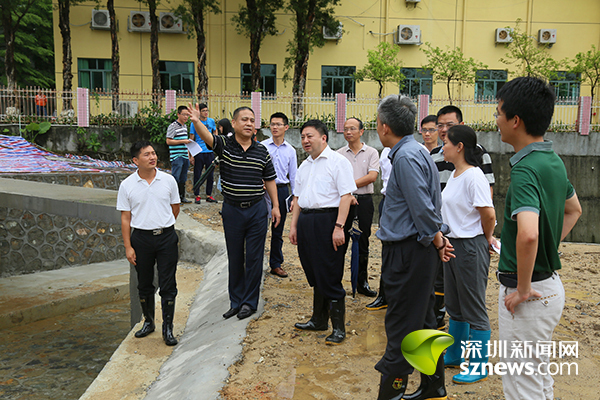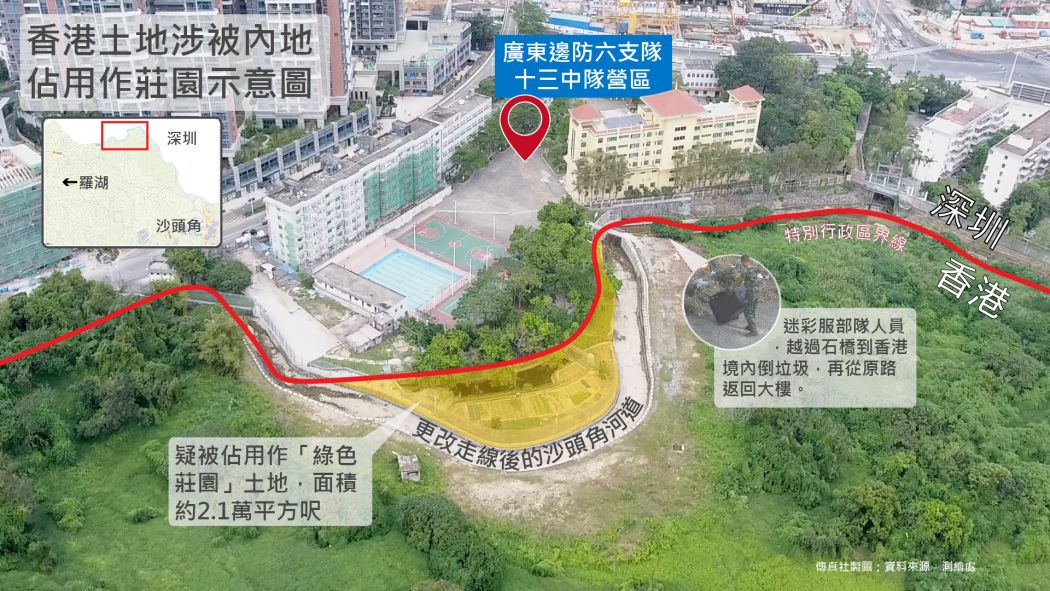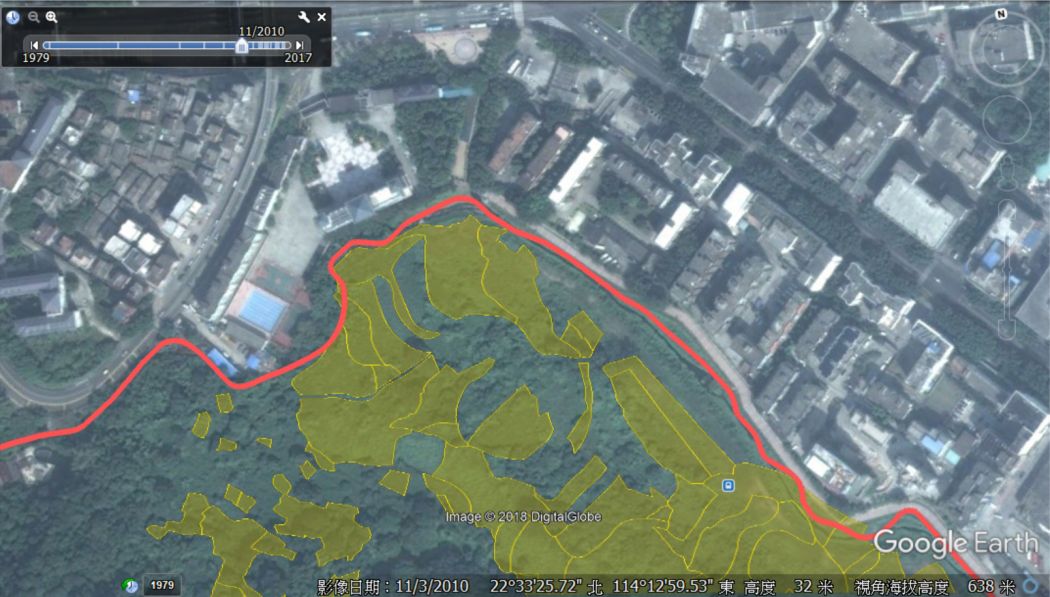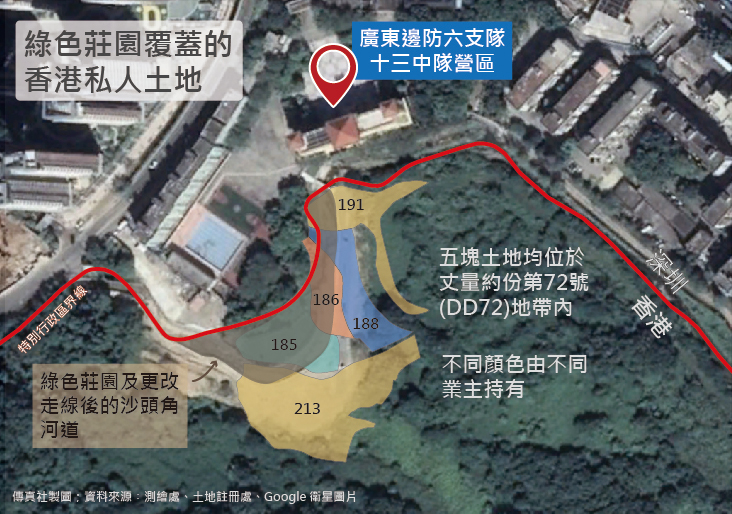Chinese border guards have quietly occupied a tract of Hong Kong land and have been using it for farming on the territory’s border with Shenzhen for at least six years, an investigation by FactWire has found.
They have also frequently transgressed into Hong Kong’s territory using a bridge on the Sha Tau Kok River, which straddles the border and was built by the mainland authorities without Hong Kong’s permission.

The occupied land, which measures about 21,000 sq ft in size, is located in Hong Kong’s Frontier Closed Area and is about 900 metres northwest of Sha Tau Kok Immigration Control Point. It borders the garrison of the 13th company of the Guangdong Border Defence Corps Sixth Detachment and is on the north bank of a U-shaped part of the Sha Tau Kok River.
Drone footage shows the area has a farm inside and is closed off by mesh fence.

A sign outside a gate between the garrison and the occupied area also states that the land was turned into a ‘green garden’ in 2012 by border guards ‘with the support of superior authorities, the Shatoujiao Office of Yantian District and the civil affairs department’ to rear fish and poultry and grow vegetables.
Next to the farm and across the Sha Tau Kok River is a concrete bridge, which connects the garrison in Shenzhen to a large tract of woodland in the Hong Kong side of Sha Tau Kok.

According to the Lands Department, the Hong Kong-Shenzhen border runs through the middle of the bridge, but FactWire has witnessed at least five soldiers, dressed in camouflage fatigues, crossing the invisible border and moving gunny bags and wheelie bins back and forth across the bridge.
Google’s satellite images of the area show that the Sha Tau Kok River originally ran along the border back in 2010, but was bent southwards into Hong Kong, creating a U-shaped section in 2012, around the time when the farm was built by the Chinese border corps garrison.

Meanwhile, photos of the concrete bridge first appeared ub an online news article in June 2017 reporting a site visit by officials from Yantian District to ‘inspect maintenance work on the Sha Tau Kok River’ – the timing of which matches satellite imagery.
The Chinese officials appear to be standing on the Hong Kong side of the border in the pictures.

When reached by FactWire on the phone, the border guard garrison’s responsible officer, who gave his surname as Liang, insisted that the farm was to the north of the river and therefore not in Hong Kong’s territory.
He then said he was not aware of any diversion work that moved the river further into Hong Kong, saying he was only assigned to the garrison late last year.

‘The area on the other side of the bridge is a buffer zone which we can enter without Hong Kong’s permission. For example, we can arrest smugglers or illegal immigrants in this area,’ Liang said, adding that he would discuss the border issues concerning the farm with Hong Kong Police’s Sha Tau Kok division.
The area believed to have been illegally occupied is separately held by four landowners, including Mr Yau, who owns nearly 15,000 sq ft of land in the affected area, and Ip Ting Ying Tso, an indigenous land trust.

Neither said they were aware of the situation with their land, nor have any received any land resumption notice from the government.
Responding to enquiries from landowners, Wong Cheuk-keung, a local lands officer at the North District Lands Office said the government had no record of any river work in the area.

‘The mainland government cannot carry out construction work in Hong Kong’s territory. Or if it was carried out by a private company, it should have contacted the landowners,’ he said, adding that he had to confirm whether the border area had been occupied by mainland authorities.
Ip Chau-ping, manager of Ip Ting Ying Tso, said his land was fenced off by the police about 10 years ago following a landslide, and since then, he was required to be accompanied by police officers in order to enter the area.

‘It is impossible that the government knows nothing about a massive river diversion project,’ he said.
Yau, who purchased the land in 1998, said he could only wait for the response of the Lands Office and might need to seek legal advice. If his land were to be legally expropriated by the government, Yau would be compensated with more than HK$5m.
The Hong Kong Police Force, the Security Bureau, the Lands Department and the Development Bureau did not immediately respond to FactWire’s requests for comment.
A large-scale maintenance project was carried out on the Shenzhen River in three phases between 1995 and 2006 by the Hong Kong and Shenzhen governments, which saw the relocation of border fencing as well as redrawing of parts of the border. But the occupied land was not included in the project.
